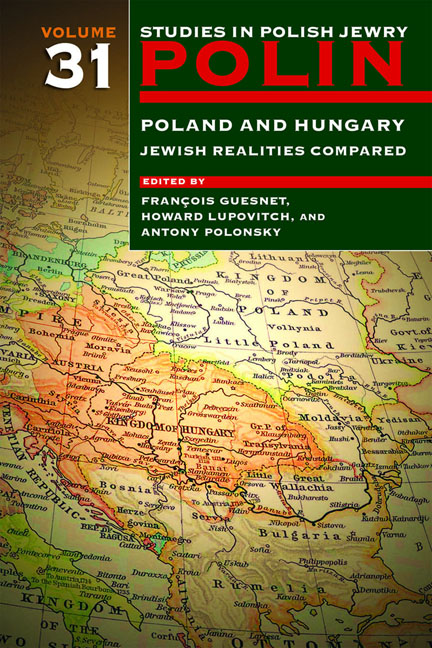Book contents
- Frontmatter
- Dedication
- Editors and Advisers
- Preface
- Polin
- Polin: Studies in Polish Jewry
- Contents
- Note on Place Names
- Note on Transliteration
- Part I POLAND AND HUNGARY: JEWISH REALITIES COMPARED
- JEWISH ACCULTURATION AND INTEGRATION
- JEWISH RELIGIOUS LIFE
- JEWS IN POPULAR CULTURE
- THE INTERWAR YEARS
- THE HOLOCAUST AND ITS AFTERMATH
- PERSONAL REFLECTIONS
- Part II NEW VIEWS
- Part III OBITUARIES
- Notes on the Contributors
- Index
Suicides of the Polish and Hungarian Types: Jewish Self-Destruction and Social Cohesion in Interwar Warsaw and Budapest
- Frontmatter
- Dedication
- Editors and Advisers
- Preface
- Polin
- Polin: Studies in Polish Jewry
- Contents
- Note on Place Names
- Note on Transliteration
- Part I POLAND AND HUNGARY: JEWISH REALITIES COMPARED
- JEWISH ACCULTURATION AND INTEGRATION
- JEWISH RELIGIOUS LIFE
- JEWS IN POPULAR CULTURE
- THE INTERWAR YEARS
- THE HOLOCAUST AND ITS AFTERMATH
- PERSONAL REFLECTIONS
- Part II NEW VIEWS
- Part III OBITUARIES
- Notes on the Contributors
- Index
Summary
EUROPE suffered from an increase in the number of people seeking to take their own lives during the period between the wars. The chaos and horror of the First World War, the crushing economic hardships that plagued much of the continent throughout the 1920s and 1930s, and new social mores in the liberal atmosphere of the post-war years led to disillusionment, dislocation, and extreme despair. The fact that more people were living longer to crowd into the same urban areas only served to create more malaise and anomie in general. Poisons and firearms were more readily accessible than ever before, and the ubiquity of multi-storey dwellings in larger cities meant that jumping was now also an option for those considering suicide.
Jews, especially the more traditional communities of eastern Europe, saw themselves as resistant to self-destruction. There was a common belief that centuries of religiously sanctioned persecution meant that there was a duty to live. As well, some speculate that the threat of real physical violence that Jews faced did not afford them the emotional luxury of focusing on the more abstract threats that most often lead to suicidal ideation: if a person has literally run for their life, professional or personal failure might be a more manageable hurdle.
Yet rates of Jewish suicide in Europe began to rise along with the rates of non-Jewish suicide—though later and slightly more slowly—first in the west and centre and spreading to the rest of the continent over the course of the nineteenth century as industrialization increased and the population grew dramatically. The First World War unleashed new realities and challenges that proved too much for many to handle, especially Jews in economically destitute countries who were subjected to antisemitic financial policies. Nevertheless, Jews in Europe, and those in eastern Europe in particular, never seemed to commit suicide in greater proportion than non-Jews, whether measured in cultural, religious, or ethnic terms.
The suicide patterns of Polish and Hungarian Jews reflected developments within their respective wider societies. Using press reports, statistics, and individual accounts, this chapter investigates the responses to and contemporary understanding of increases in suicidal behaviour and of suicide itself among Jews in the Hungarian and Polish capitals between the wars.
- Type
- Chapter
- Information
- Polin: Studies in Polish Jewry Volume 31Poland and Hungary: Jewish Realities Compared, pp. 329 - 348Publisher: Liverpool University PressPrint publication year: 2018



